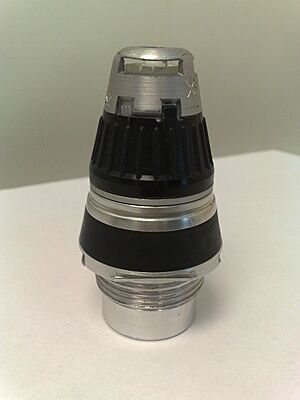Fuze facts for kids
In the military, a fuze is a special part of an explosive device. It makes the device explode at the right time or place. Think of it as the "brain" that tells a bomb or missile when to go off. Sometimes, especially in torpedoes, a fuze might be called an "exploder."
The word "fuze" (with a "z") is often used for these advanced military devices. They have complex mechanical or electronic parts. This helps to tell them apart from a simple "fuse" (with an "s"), which is a burning cord or an electrical safety device.
Types of Fuzes
Fuzes work in different ways to make sure an explosion happens when needed.
Time Fuzes
A time fuze is set to explode after a certain amount of time. Imagine a countdown timer. Once the time runs out, the fuze triggers the explosion. These are useful for things like grenades or bombs that need to explode in the air after being dropped.
Impact Fuzes
An impact fuze, also called a contact fuze, explodes when it hits something. This is usually the target it was aimed at. For example, a bomb hitting the ground or a missile hitting a building would use an impact fuze to detonate.
Proximity Fuzes
A proximity fuze is very clever. It uses sensors to make the explosive device blow up when it gets close to a target, but without actually hitting it. These sensors can be different types, like:
- Radar: Sends out radio waves and listens for them to bounce back.
- Sonar: Uses sound waves, often underwater.
- Infrared: Detects heat.
- Magnetic: Senses changes in magnetic fields.
- Photoelectric: Detects light.
- Seismic: Senses ground vibrations.
- Even television cameras: Can "see" the target.
No matter what sensor is used, a proximity fuze makes the explosion happen near the target. This can destroy or severely damage the target, even if there isn't a direct hit.
Images for kids
-
Mk 53 Proximity fuze for an artillery shell, around 1945.
See also
 In Spanish: Espoleta para niños
In Spanish: Espoleta para niños




